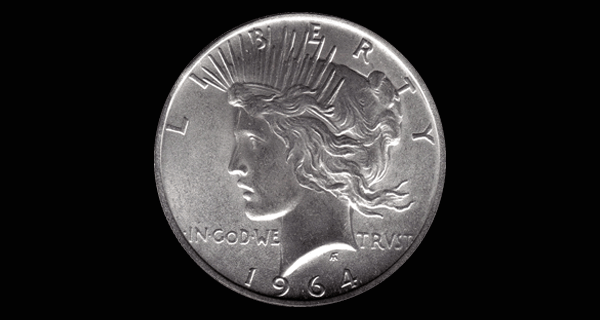A Brief Resurrection: The Peace Dollar
Jan 24th 2019

A fantasy restrike of the infamous 1964-D Peace dollar. Image: WikiMedia Commons
A Peace dollar from the 1960s? Get outta here. We all know the Peace dollar series ended in 1935... or did it? Briefly resurrected and quickly destroyed in the 1960s, this particular Peace dollar is the stuff of legends.
In 1964, American culture, technology and entertainment was evolving with astonishing speed. President Lyndon B. Johnson declared “War on Poverty,” the Civil Rights Act of 1964 passed, health warnings were mandated to appear on all cigarette packaging and Martin Luther King, Jr. was awarded the Nobel Peace Prize. The Kennedy half dollar abruptly replaced the Franklin and began to circulate — and for just eight of those JFK halves, boys across the nation could buy the brand new GI Joe action figure.
The Beatles began their first U.S. tour and Clint Eastwood landed his first starring role in the spaghetti western, A Fistful of Dollars. The 1964 New York World’s Fair paid tribute to America as an economic powerhouse and as a leader in both industry and technology. Even entertainment giant Walt Disney contributed to the fair, debuting pioneering audio-animatronics in the now-famous theme park ride, It’s a Small World.
1964 also shares its date with the resurrected Peace dollar.
Although authorized by Congress and dated 1964, the Peace dollar wasn’t actually struck until 1965. In the 1960s, the price of silver had begun to rise. Coin shortages were becoming more and more common; fingers were pointed at investors and collectors for hoarding, which prompted Congress to enact a date-freeze (presumably to deter said hoarding). Growing demand from the public and pressure from silver states (states whose economies relied heavily on either mining or coins [think western Casinos]) led President Johnson to green light the production of $45 million silver dollars.
The Denver Mint began striking Peace dollars of the same weight and composition as the initial series in the spring of 1965. Thirty trial strikes and only 316,076 business strikes were produced. It was speculated that the release of the 1964 Peace dollar would only lead to more stockpiling — coin dealers had already begun advertising to collectors for high premiums; therefore in an effort to curtail further silver shortages, Congressional opposition successfully halted minting.
This is where it gets tricky. The coins were weighed in quantity before melting. The only way to ensure all were destroyed would have been to individually count and inspect each coin. Numismatic gumshoes have theorized the possibility that employees of the mint may have pulled the ol’ switcheroo, replacing the ‘64s with genuine Peace dollars. It’s also speculated that Peace dollars may have been gifted to official members of the government (like the *cough* President himself) — not an uncommon practice for a new coin’s release.
Based on U.S. Mint documents, it is known that two of the trial strikes were sent to the Treasury for official inspection, where they lived quietly in a vault until their discovery in 1970 and then were hastily destroyed. If the whereabouts of two of these infamous Peace dollars were unknown for five years, it’s not much of a stretch to believe there may be more specimens out there, is it?
If any do indeed exist, the 1964-D Peace dollar would be one of the most valuable coins in the world. But don’t get too excited yet… because these coins were never officially issued, they still belong to Uncle Sam.

